No products in the cart.
NZDA News Article, Infection Prevention and Control
IPC COMPLIANCE…It’s a mindset!
There is continued talk of burn-out and stress currently. So, it’s time to do some serious self-care. Many of us are good at the concept but bad at the execution. Added pressures of clinical life can be another layer of unnecessary and sometimes avoidable stress.
A frequent comment to me is… “arrrghhh compliance!—it’s a nightmare”. Let’s make this the year that nightmare goes away.
Being compliant is not necessarily something we do, but something we are. Maybe a change of perception is in order. Following policies and procedures are task-based requirements, whereas doing those things in a compliant manner requires a specific behaviour—one that is compliance focused. The more I observe and audit, the more I have come to understand that a ‘mindset’ of compliance is the key. It’s a way of thinking, as opposed to ‘following the rules’.
Compliance is key, as they say. Is compliance generally regarded as a positive word? Does it generate a positive or negative reaction? For most people, compliance means something mandatory, and therefore usually something unpleasant or undesirable. Compliance implies there is a lack of freedom because we are restricted in some way or have some rules we must follow.
Compliant. adjective. com.pli.ant kəm-ˈplī-ənt. : ready or willing to comply.
Synonyms: complaisance, compliancy, deference, obligingness. Type of agreeableness. A temperamental disposition to be agreeable. Acting according to certain accepted standards. synonyms: abidance, conformation, conformity.
The etymology of the term compliance can be traced to the Latin verb “complere” (having all parts or elements; lacking nothing). Complere is also the source of the English word “complete”. Compliance consists of being amenable, being obedient to the other party, and fully meeting demands. Interesting!
Behavioural compliance is a new approach that helps organisations and businesses embed compliant practices into their everyday work processes.
What is a better or maybe more considered word for compliance?
Perhaps it may be… Reciprocity; cooperation, exchange, mutuality, reciprocation. Easily described using other words such as; satisfaction, reimbursement, amends, repayment, atonement, payment, reward.
In other words, reciprocation is that of mutual benefit and/or mutual exchange. A two-way street, requiring both give-and-take for success. Truly the basis of a team managed approach—critical for effective and efficient dentistry and for a compliant management/approach to IPC.
Daniel Pink’s theory of motivation (‘MAP’)—mastery, autonomy, and purpose. Suggests providing all three of these things will trigger intrinsic motivation factors. A model that casts away the idea of reward and punishment as motivational tools and, instead, focuses on what it takes to make people really care about what they do. Pink’s theory, drawn from research by psychologists Harry Harlow and Edward Deci, and subsequent studies by MIT professors, recorded similar findings. Discovering rewards can fail to improve people’s engagement with tasks and may even damage it.
Pink argues that the traditional ‘carrot and stick’ approach to motivation has become outdated, not adequate for current workplaces. Unfortunately, extrinsic motivation using rewards external to work, is often deep-rooted, particularly among older employees who may be accustomed to it.
In contrast, intrinsic motivation, when people are self-motivated because they’re given freedom to do work they enjoy, is increasingly common. Innovation and creativity are key. So, it’s essential that people are allowed to thrive by doing work that they’re truly passionate about.
“Do the best you can until you know better. Then when you know better, do better”—perfectly appliable to all things IPC related. A continual journey of tweaks, ongoing learning, product and equipment developments. Requiring a fundamental basis of basic microbiology underpinning methods of transmission, Standard and Transmisison Based Precautions, Hand Hygiene and PPE, a layer of biochemistry for aerosol and surface management, instrument management and products, and finally basic physics for the science of sterilisation. Oddly basic and complex at the same time!
Set the intention! Sometimes the day just doesn’t go to plan… lateness, equipment failure, unplanned patient, or treatment to be scheduled (squeezed!) in, inefficient systems, the clinician brings in the next patient too quickly. Seem familiar sometimes?
When one or more of these things happen, it can lead to corners being cut with the aim of getting the day back on track.
The unintended consequence of busyness
What are the consequences of not performing correct IPC procedures?
- What if the correct PPE is not worn when mixing chemicals such as suction cleaners?
Eyewear (without side protection), no mask, and/or no gloves can result in chemical burns to the skin or eyes. A brief google of ‘cooked fish eye’ should be sufficient to raise a few eyebrows and encourage a focused rethink.
“That won’t happen to me/us” … a common response to a “what if” question.
That may be due to what is called “Optimism bias,” a psychological tendency to feel you’re safer than others, according to neuroscientist experts. Some people are simply more complacent than others about risk and many believe they will be ‘safe’. Many are able to deny the reality of a situation, minimise or dismiss the importance of potential issues, or just not realise how high their risk profile may be.
Several things add up to a healthy team approach to managed compliance and positively reinforced behaviours, in turn ultimately reducing risk and keeping people and businesses safe.
These things include;
- Regular staff meetings and team training sessions to refine and improve systems so that every team member understands and is confident to work efficiently and safely
- Setting up for success—planning and structure
- Focusing on results
- Understand different learning styles for successful training.
Structured meetings are successful meetings. Set yourself up for success, whether it is your staff meeting or daily morning huddle:
- Create an agenda—know what to discuss, have an idea of outcomes you want to reach. Send out the agenda beforehand.
- Roles—share the work and have the team participate in meetings also by sharing facilitator and notetaker roles.
- Pick a time that ensures there will be the maximum number of staff present, and when you can start on time. Remember to keep an eye on the time and finish on time also.
- Invest the time fully—put a sign on the door and lock it, with answer-phone on.
Generally, meetings come at the expense of production time, so getting the most from time invested is important. Get a talkative person to concisely convey their words and leave time for others to speak (sitting by them may help keep them quiet and focused). Make sure everyone gets a chance to talk. Encourage shyer people to contribute and share their thoughts.
“Would you like to say something?” Sometimes discussing in pairs briefly before bringing it to the group helps shy people.
Politely bring conversation back to topic (particularly if a junior team member is facilitating)—“Have we strayed from the topic?”, “Is this what the rest of the team thinks?”, “Maybe we misunderstood our roles/purpose?”, “So far we have discussed (summarise)”, “What do you want to do?”
Avoid the ‘Drama Triangle’—when people say different things to different people, it becomes hard to address the real issue. The worst!!
Everyone’s talking about it to others instead of talking about it together directly. Have each person share their perspective. Work together to identify common issues and themes. Approaching situations with compassion and empathy, can be very trust-building.
“I hear, and I forget. I see and I Remember. I do and I understand.”
Confucius
Team training plays a significant role in ensuring IPC compliance. Attending training sessions together ensures team members hear the same information at the same time and can be on the same page with regards to IPC processes.
Comprehensive induction training, along with scheduled yearly updates, is a must for all members of the team.
Having a cohesive team that is updated and has a team focused approach to IPC guidelines is key to ensuring compliance. By addressing any differences and getting everyone on the same page with well-designed training sessions, IPC processes remain a positively considered priority in practices.
Learning styles come in different shapes. Assess the team’s learning styles to ensure a greater level of support can be provided and highly impactful outcomes can be achieved.
Learning Styles—a brief overview of the 4 styles of learning can be helpful.

Visual Learners: Tend to describe the world around them with visual words; look, see, colourful, imagine, watch. Often start a sentence with “Look… and are normally quite quick speakers. Sometimes can come across as detailed and therefore quite wordy.
Tools for training visual learning styles:
- Video; short ones on phone that can be kept for reference, and demonstrations
- Pictures on screen or slides with images only
- Let them draw on a whiteboard, use different coloured markers!
- Posters to act as anchors in the tea room
- Show and tell, demonstrate the skills
- Posters, slides, pictures, diagrams, hand-outs, flow charts, photographs, illustrations, anecdotes, manuals, visualisations.
Auditory Learners: Like to describe the world in the way they hear it, using words such as hear, listen, sounds like, resonates and they often start a sentence with “Listen… They can come across as a bit slower when they speak as they wish to choose the right words, sometimes resulting in more monotonous and less lively dialogue.
Tools for training auditory learning styles:
- You telling / Them telling / Tell someone else / Repeat information – teach back
- Close your ears and listen
- Chat between two team members
- Podcast
Kinesthetic Learners: Tend to describe the world in words that describe what things feel like. They are hands on and use senses like taste, smell, and feel. Often use words like; feel, comfort, touch. Often combined with preference for visual learning.
Tools for training kinesthetic learning styles:
- Practical, hands-on, doing, trying, holding, feeling, smelling, tasting, touching
- Models
- Practice, practice, practice
Internal Dialogue Learners: They describe the world in facts and details, enjoy logic and want things to make sense. Can often frown when they learn as they process and are trying to make sense of things. Will often ask and use the word “Why?” (they like to understand, it’s an important part of their process).
Tools for training internal dialogue learning styles:
- Clear objectives
- Logic, purpose, facts, details, systems
- Handouts; written information and diagrams, include quiz/questions
Plan a training agenda and delegate.
Clearly communicated structure will help support all learning styles;

Team meetings will help with team engagement, and engaged team members are motivated to learn and be compliant.
What is the concept of reciprocity? The reciprocity principle is one of the basic laws of social psychology. It says that in many social situations we pay back what we received from others. A solid team approach to IPC management in dental practice is an excellent example of this. Essentially each team member is ‘looking out’ for the other.
What does ‘encourage compliance’ mean? Isn’t it better to encourage as opposed to demand? Go further than ‘just ticking the box’ for compliance. Employees become more motivated to do the right thing when they have mastered it, autonomy to think and do, and the purpose defined.
Key Elements of an Effective Compliance Programme
- Written policies and procedures (manual)
- Designated compliance officer and/or compliance committee (IPC Co-ordinator)
- Effective training and education
- Effective lines of communication
- Internal monitoring and auditing
Management of the compliance workflow should be an intuitive, and simple-to-use platform that helps compliance and teams manage their duties. As opposed to onerous and sometimes unintended overzealous use of spreadsheets and manual processes.
Focus on an ability to display efficacy in real-time where possible and keep documentation simple. Recording and correcting activities will also help you to develop a higher level of compliant behaviours with documented self-audit trails with targeted corrective action plans.
How do you demonstrate compliance?
5 Simple Steps to Ensure Compliance —emphasis on ‘keeping it simple.’
- Stay updated with changing standards and regulations.
- Involve specialists. Avoid unintended consequences that may have significant impact.
- Ensure the team follows procedures.
- Schedule regular internal audits.
- Use software for schedules, registers, and sterilisation documentation.
Be the leader and lead by design. The importance of leadership in IPC compliance is imperative. Lead by example and take ownership of the IPC process within the practice. Create and implement an Infection Prevention Management Plan, have clear policies and procedures in place, nominate an IPC Coordinator, keep updated with relevant guidelines and train, train, train.
In addition, regularly test, monitor, and document IPC processes. Ensure batch control identification (BCI) is completed, recorded, and transferred to patient notes. A comprehensive Quality Assurance programme, including regular audits (preferably by you), is necessary for a properly validated IPC process.
Taking ownership of the IPC process, and having a cohesive team is the objective.
Good leadership will further enhance the team spirit and always support a ‘compliant thinking approach’—the reciprocity rule applies here well.
In simple words compliance is the state of being in accordance with established guidelines or specifications, or the process of becoming so…
Let’s not add IPC or compliance stress to the list anymore!
“Smile, Breathe and Go Slowly”
Thich Nhat Hanh
—
This article originally appeared in Volume 212, March 2023 of NZDA News.



 Coaching Solutions
Coaching Solutions













